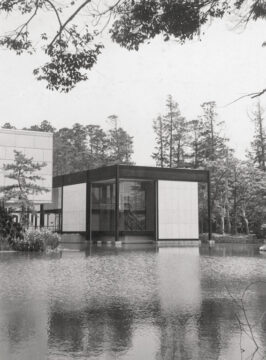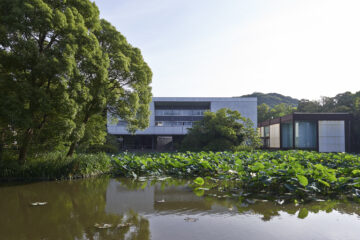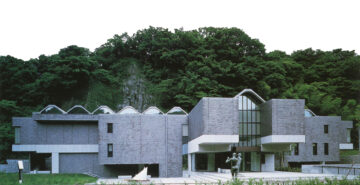About us
History of the Museum
The Museum of Modern Art, Kamakura
The Museum of Modern Art, Kamakura first opened its doors on 17 November, 1951. The idea for the Museum was conceived in 1949 at a gathering of resident artists, scholars, and critics of Kanagawa Prefecture, who felt the need for activities that provide cultural and artistic guidelines in a period of social confusion and rebuilding following World War II. Deciding to work together to establish an art museum, they formed the Kanagawa Prefecture Artists’ Assembly. The founding in 1951 of this first public museum of modern art in Japan, housed in a building designed by Junzō Sakakura, was widely welcomed with great anticipation.
Modeled after the Museum of Modern Art in New York, it has continued to win recognition for activities that it began based on tenets that can be summarized as follows:
- To introduce the modern and contemporary art of Japan to the world and the Japanese public, in an effort to promote mutual understanding between Japan and the world. Also, to define the place of contemporary Japanese art within the larger context of international art.
- To introduce the development of Japanese modern art and to evaluate it historically from a contemporary perspective in order to make it comprehensible to the contemporary viewing public.

The Museum’s inaugural exhibition was “Cézanne and Renoir.” Thereafter, it has continued to help define the history of art by organizing exhibitions of works by foreign artists, various theme exhibitions, and especially exhibitions of works by important modern Japanese artists such as Yuichi Takahashi, Tetsugorō Yorozu, Seiki Kuroda, Yūzō Saeki, and Shunsuke Matsumoto. By the time of its fiftieth anniversary, the Museum had organized over six hundred exhibitions. As can be seen from the tenets above, the Museum centered its activities around temporary exhibitions when it first began, and this policy has remained unchanged to the present. Supporting such activities, however, is the day-to-day research conducted by the Museum’s curators. Together with the exhibitions it has organized, the Museum can be proud of its many accomplishments in the field of scholarly research as well. Additionally, through its exhibitions, the Museum has built close relationships with artists, collectors, art enthusiasts, and the families of deceased artists, who have graciously helped to built what is today one of the finest collections of art housed in a public art museum in Japan.

In 1966, an extension was constructed next to the original building. With another gallery and a storage room to hold the growing collection of artworks, it allowed the Museum to expand its range of activities. The design was once again entrusted to Junzō Sakakura.
In 1999, it was amongst the 20 selected architectures of modern Japan by DOCOMOMO (Documentation and Conservation of buildings, sites and neighborhoods of the Modern Movement). The appealing aspect of the building and its environment more than compensated for the lack of facilities (such as elevators).

The Museum od Modern Art, Kamakura closed on March 31, 2016. New wing was demolished and main building was transferred to Tsurugaoka Hachimangu Shrine in 2016. Main building was designated as a national important cultural property in 2020.
The Museum of Modern Art, Kamakura Annex

As the collection continued to grow over the years, however, the need again arose for more storage space and more gallery space for the permanent exhibition. Construction of the Kamakura Annex was therefore undertaken and finished in 1984. The open-air sculptures in the Annex’s front courtyard are a reflection of the Museum’s successful efforts to vitalize contemporary Japanese sculpture.
Kamakura Annex, which opened its doors in July 1984, is situated 350 meters north of the former Museum of Modern Art, Kamakura (closed in March 2016). It was designed by Masato Otaka (1923-2010) and was elaborately designed to blend in with the surrounding suburban landscape amongst the mountains.
Is it over thirty years since its opening, the facilities and equipment at the Kamakura Annex undergo improvement work as they have deteriorated over the years. The Kamakura Annex was closed from September 2017 to September 2019 with the aim of replenishing the Museum’s facilities and activities. The current renovations have seen the renewal of the exhibition gallery walls and a newly added café. The newly refurbished Kamakura Annex, which has re-opened on October 12, 2019, will be carrying on the history and tradition of the former Kamakura building, inheriting its ambition of regarding art from around the world with new eyes, while also making a fresh start.
The Museum of Modern Art, Hayama

As the Museum ceaselessly conducted its energetic activities, it continued to face various issues such as meeting societal demands, storing an ever-growing collection, and dealing with exhibitions that were becoming larger in scale. Accordingly, in 1994, the Committee for the Reorganization and Planning of the Museum was established and began looking into a new organization for the Museum in the coming century. After careful study, the Committee made the decision in 1997 to construct a new museum on Isshiki Beach in the town of Hayama. After the building was designed by AXS SATOW INC., the application for the PFI project was finished in 2001, and soon thereafter, construction began. The construction work of the Museum of Modern Art, Hayama took a year and a half. Upon its completion in March 2003, a new building emerged along the coastline overlooking the sea.

